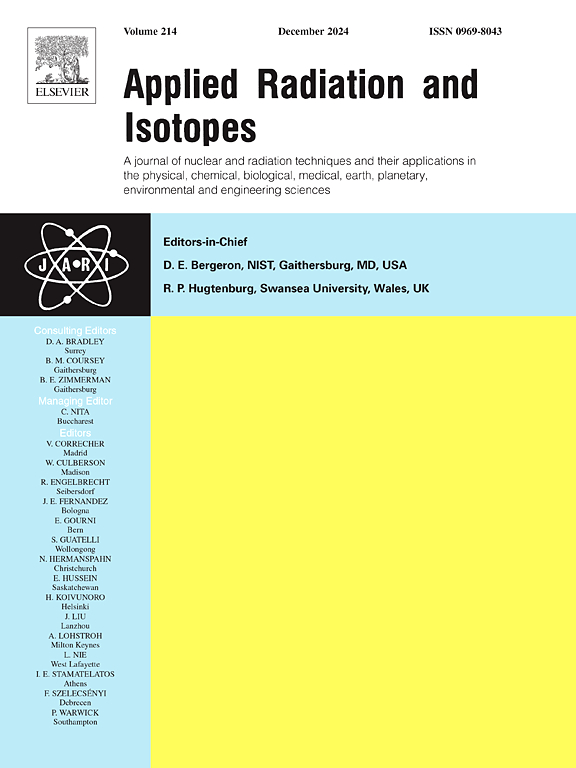The adsorption of cesium by sulfonic acid functionalized hollow mesoporous silica microspheres
IF 1.6
3区 工程技术
Q3 CHEMISTRY, INORGANIC & NUCLEAR
引用次数: 0
Abstract
With the development of nuclear industry, radioactive elements such as 137Cs put a threat on the water environment. It is a challenging task to remove the Cs+ in the nuclear wastewater. In the current study, we prepared a new Cs+-adsorbing material by introducing sulfhydryl group onto the surface of hollow mesoporous silica microspheres, then oxidizing the sulfhydryl group to sulfonic acid group. The obtained HMSS-SO3H material had an excellent adsorption capacity for Cs+ in the aqueous solution, with an adsorption capacity of 51.53 mg g−1 in 30 min. Characterization approaches, such as FT-IR and EDS, were used to confirm the result of modification. Adsorption experiments were carried out under. The influence of various parameters on the adsorption process was investigated under the conditions of changing pH, temperature, and time. The effect of competitive ions was also explored. The results indicated that the adsorption process followed the pseudo-second-order model and the main adsorption mechanisms are electrostatic interaction and coordination. The material had a best adsorption performance at a neutral pH. The adsorption process could well-fit the Langmuir's model, with a theoretical maximum adsorption capacity of 81.31 mg g−1. And the adsorption capacity was slightly affected by competing ions such as Mg2+ and Ca2+. The results indicate that the HMSS-SO3H prepared in this study is a promising adsorbent for Cs+, with the advantages of high adsorption capacity, fast adsorption rate and high selectivity.
磺酸功能化中空介孔二氧化硅微球对铯的吸附
随着核工业的发展,137Cs 等放射性元素对水环境造成了威胁。如何去除核废水中的 Cs+ 是一项具有挑战性的任务。在本研究中,我们在中空介孔二氧化硅微球表面引入巯基,然后将巯基氧化为磺酸基,制备了一种新型 Cs+ 吸附材料。得到的 HMSS-SO3H 材料对水溶液中的 Cs+ 具有极佳的吸附能力,30 分钟内的吸附量为 51.53 mg g-1。傅立叶变换红外光谱(FT-IR)和 EDS 等表征方法证实了改性结果。在以下条件下进行了吸附实验。在改变 pH 值、温度和时间的条件下,研究了各种参数对吸附过程的影响。还探讨了竞争性离子的影响。结果表明,吸附过程遵循伪二阶模型,主要的吸附机理是静电作用和配位作用。该材料在中性 pH 条件下具有最佳的吸附性能。吸附过程完全符合 Langmuir 模型,理论最大吸附容量为 81.31 mg g-1。吸附容量受 Mg2+ 和 Ca2+ 等竞争离子的影响较小。结果表明,本研究制备的 HMSS-SO3H 是一种很有前途的 Cs+ 吸附剂,具有吸附容量大、吸附速率快和选择性高等优点。
本文章由计算机程序翻译,如有差异,请以英文原文为准。
求助全文
约1分钟内获得全文
求助全文
来源期刊

Applied Radiation and Isotopes
工程技术-核科学技术
CiteScore
3.00
自引率
12.50%
发文量
406
审稿时长
13.5 months
期刊介绍:
Applied Radiation and Isotopes provides a high quality medium for the publication of substantial, original and scientific and technological papers on the development and peaceful application of nuclear, radiation and radionuclide techniques in chemistry, physics, biochemistry, biology, medicine, security, engineering and in the earth, planetary and environmental sciences, all including dosimetry. Nuclear techniques are defined in the broadest sense and both experimental and theoretical papers are welcome. They include the development and use of α- and β-particles, X-rays and γ-rays, neutrons and other nuclear particles and radiations from all sources, including radionuclides, synchrotron sources, cyclotrons and reactors and from the natural environment.
The journal aims to publish papers with significance to an international audience, containing substantial novelty and scientific impact. The Editors reserve the rights to reject, with or without external review, papers that do not meet these criteria.
Papers dealing with radiation processing, i.e., where radiation is used to bring about a biological, chemical or physical change in a material, should be directed to our sister journal Radiation Physics and Chemistry.
 求助内容:
求助内容: 应助结果提醒方式:
应助结果提醒方式:


